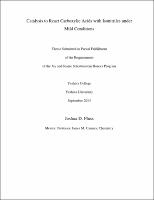Please use this identifier to cite or link to this item:
https://hdl.handle.net/20.500.12202/4109Full metadata record
| DC Field | Value | Language |
|---|---|---|
| dc.contributor.author | Fluss, Joshua D. | |
| dc.date.accessioned | 2018-11-06T19:22:54Z | |
| dc.date.available | 2018-11-06T19:22:54Z | |
| dc.date.issued | 2013-09 | |
| dc.identifier.uri | https://hdl.handle.net/20.500.12202/4109 | |
| dc.identifier.uri | https://ezproxy.yu.edu/login?url=https://repository.yu.edu/handle/20.500.12202/4109 | |
| dc.description | The file is restricted for YU community access only. | |
| dc.description.abstract | Previous research has shown that isonitriles and carboxylates react in a simple two-component coupling (2cc) reaction to form homogenous N-linked glycoproteins via 1,3 O N acyl transfer. However, activating the reaction required heating the reaction mixture in a microwave to 150 °C. Our research proposed to overcome the problem of high activation energy by finding a suitable iron-based catalyst. We aimed to synthesize an iron half-sandwich complex with two phosphine ligands, to allow for control over the sterics and electronics of the catalyst, and we included an hydrogen-bonding residue to facilitate the 1,3 O N acyl transfer. We successfully synthesized the desired target complex [CpFe(PMe3)(3-pyPPh2)(CyNC)][PF6], but could not isolate it in high purity. Upon further investigation, it was found that the ligands of [CpFe(PMe3)(3-pyPPh2)(CyNC)][PF6] redistribute in solution, precluding its isolation in high purity. We proceeded with studies of the reaction of [CpFe(PMe3)(3-pyPPh2)(CyNC)][PF6] with propionic acid, and observed no reaction between the complex and propionic acid. Attempts to carefully oxidize the complex from Fe2+ to Fe3+ in the absence of any excess CyNC yielded a stable Fe3+ derivative, but this complex also appeared not to react with propionic acid. Other efforts to synthesize a capable and inherently less electron rich catalyst candidate, [CpFe(CyNC)(CO)2][PF6], were successful. After isolating the complex, studies did not appear to show any reactivity with carboxylates. Future studies will look to oxidizing the iron in [CpFe(CyNC)(CO)2][PF6] to Fe3+, which will hopefully make the complex electron poor enough to induce nucleophilic attack on the coordinated isonitrile. | en_US |
| dc.description.sponsorship | Jay and Jeanie Schottenstein Honors Program | en_US |
| dc.language.iso | en_US | en_US |
| dc.publisher | Yeshiva College | en_US |
| dc.rights | Attribution-NonCommercial-NoDerivs 3.0 United States | * |
| dc.rights.uri | http://creativecommons.org/licenses/by-nc-nd/3.0/us/ | * |
| dc.subject | Carboxylic acids. | en_US |
| dc.subject | Isocyanides. | en_US |
| dc.title | Catalysis to React Carboxylic Acids with Isonitriles under Mild Conditions | en_US |
| dc.type | Thesis | en_US |
| Appears in Collections: | Jay and Jeanie Schottenstein Honors Student Theses | |
Files in This Item:
| File | Description | Size | Format | |
|---|---|---|---|---|
| Joshua-Fluss.pdf Restricted Access | 1.87 MB | Adobe PDF |  View/Open |
This item is licensed under a Creative Commons License

